The appointment of Masarat Alam as head of the Geelani faction of the All Parties Hurriyat Conference indicates that Pakistan is playing safe —perhaps as it prepares other plans.
Masarat is not considered an imaginative, or even charismatic leader, but is committed to pan-Islamism, and faithfully toes Pakistan’s line. Geelani had already been replaced as Tehreek-e-Hurriyat chairman when Ashraf Sehrai had been nominated to take his place by fiat from Rawalpindi.
Alam is also apparently to take over Tehreek-e-Hurriyat, the organisation that Syed Ali Shah Geelani had launched after he was formally expelled from the Jamaat-e-Islami. It is a part of his faction of the Hurriyat Conference. Both positions fell vacant this year, since Sehrai died of COVID in May.
There was much talk of Geelani having wanted his son to succeed him, but Pakistan would not have wanted this to seem like a family business. Nor would ISI officers have been happy that the sons were unable to ensure a massive public show of strength around their father’s death.
There was almost no public reaction at Geelani’s death. Indeed, friends based in long-time Jamaat strongholds such as Shopian say very few would have gone for the funeral even if the government had not imposed restrictions on movement and communication.
Pan-Islamist Terrorist
Masarat Alam was a militant commander of Hizbullah, one of Kashmir’s smaller terror outfits, in the 1990s. It was founded by Mushtaq Ahmad Bhat aka Guga sab, the most pan-Islamist of Kashmir’s terror figures. He had passionately dug up a Srinagar cricket pitch during a match against the West Indies in 1983, as a gesture of protest.
Masarat didn’t make much of a mark as a terrorist, for militancy in Kashmir had been largely taken over by Pakistani and Afghan fighters by the mid-90s. Thereafter, (largely Pakistani) men of Lashkar and Afghans (either in Harkat-ul Mujahideen, Harkat-ul-Jihad Islami, or later Jaish) took the lead. Kashmiri militants largely supported them with logistics and as guides.
It was in December 1992, eight months after the fall of Kabul to Pak-backed forces led by warlords such as Rabbani and Hikmetyar, that the ISI cleared Lashkar and Harkat to formally join the Kashmir jihad. Earlier, Afghans would sometimes come to Kashmir as part of the Gujjar-dominated Al Barq.
2010 'Calendars'
Masarat really came into the limelight when he issued a series of 'calendars,' instructing people at large on how and where to conduct agitations during a mass uprising in 2010.
Large groups of boys had been pelting stones at the police and the CRPF from quite early that summer. Those agitations had begun in Downtown Srinagar, but then spread to different corners of the Valley, as killings continued.
The agitating boys, later joined by mothers and others, were irate at the deaths of innocents in security force actions—including the murder of three boys who had gone to an army camp in search of work, the killing of a boy by a bullet fired from a passing jeep in Brein, and the death of a Downtown boy at whose head a tear-gas canister was apparently fired.
The daily cycle of stone-pelting, rebellious dances, lathi charges, and firing went on for weeks, until Masarat’s 'calendars' emerged. They gave instructions about which section of the population was to demonstrate where, on which day, and how. People began to wait for those 'calendars' with great enthusiasm. Chaos ensured, and Kashmir was in a tailspin for a while.
It was intriguing that the government released Masarat from jail just a little before he took over those agitations from a secret location. He was finally found, and arrested again.
There is little doubt that the operation involving 'calendars' was managed by the ISI, using Masarat as the front man. Some of those who have worked with him say he was not bright or imaginative enough to come up with those on his own.
Under Pressure for the Moment
It is ironic that nothing much came of a 'calendar' of putative agitations which was circulated in Kashmir on Monday, 6 September.
Since Masarat is in jail again, it is unlikely that either the Tehreek-e-Hurriyat or the Hurriyat (G) will become any more active than they have been for the past few years.
Separatist politics has been largely silenced since a range of leading lights, including Geelani’s son-in-law, were arrested in July 2017. More recently, many Jamaat-e-Islami leaders too have been arrested, and the organisation banned.
In addition, many of the Jamaat’s adherents who are in government service have been sacked, or transferred, over the past ten months or so.
The fact that there has been almost no unrest following Geelani’s death indicates that the place will remain quiet for the moment. A lot of Kashmiris have been expectantly waiting for foreign intervention to trigger another campaign. Interesting times could lie ahead.
(David Devadas is the author of 'The Story of Kashmir' and 'The Generation of Rage in Kashmir' (OUP, 2018). He can be reached at @david_devadas. This is an opinion piece and the views expressed above are the author’s own. The Quint neither endorses nor is responsible for the same.)
(At The Quint, we question everything. Play an active role in shaping our journalism by becoming a member today.)
